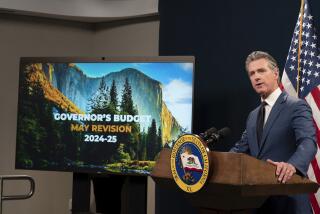State’s Delegation Makes Final Plea to Save 15 Bases : Military: Lawmakers say California faces loss of far more than its share of jobs from closures. Some members attack other installations in attempts to protect those in their districts.
Seizing a final opportunity to plead for thousands of military jobs, a delegation of California lawmakers Monday urged an independent panel to spare the state further economic hardship from the possible closure of 15 bases.
A parade of 17 members of Congress told the Defense Base Closure and Realignment Commission that California has suffered a disproportionate share of job losses from two earlier rounds of cuts. They argued that several military studies that attempted to justify the California base closings were riddled with inaccuracies and omissions.
While Democratic Sens. Dianne Feinstein and Barbara Boxer joined with other legislators in a unified effort to avoid further base closings statewide, some House members began attacking other California bases in attempts to protect installations within their districts.
California has 15 major facilities on the base closure list being examined by the citizens panel. These include the El Toro Marine Air Station and Tustin Marine Corps Air Station in Orange County, Long Beach Naval Shipyard, March Air Force Base near San Bernardino, and Miramar Naval Air Station and the Naval Training Center in San Diego. In all, the proposed base closures and realignments would put 78,302 military and civilian personnel out of work in California.
The first of three days of continuous hearings began Monday to give members of Congress from 38 states, the District of Columbia and Guam one last shot before the commission decides which bases should be shut down. The panel must forward its recommendations to President Clinton by July 1.
The first Californian to speak was Feinstein, who said that counting the 15 threatened bases, the state would sustain as much as 55% of all Defense Department personnel cuts since 1988 even though it has only 15% of Pentagon jobs.
“California can’t take any more base closure hits,” Feinstein said. “We have done our fair share. This round of base closures, as it now stands, is simply unfair to California.”
Other state lawmakers took turns lobbying on behalf of targeted bases in their districts. Most argued that it was not feasible to close many of the large California military facilities because they are critical to military preparedness and economically cost-effective to operate.
Rep. Steve Horn (R-Long Beach) said Long Beach Naval Shipyard should remain open because it is rated the third-most militarily valuable shipyard in the Navy and has the only dry-dock in the region south of Puget Sound that can accommodate a full range of Navy ships.
Rep. Dana Rohrabacher (R-Huntington Beach), who formerly represented Long Beach, urged the commission to “see through” arguments offered by proponents of saving Mare Island Naval Shipyard in Vallejo. He pointed out that the Mare Island facility was ranked “dead last” in military preparedness.
“Two years ago, Long Beach Naval Shipyard was the target of false charges coming from the desperate supporters of the Philadelphia Naval Shipyard,” Rohrabacher said. “This time, the desperate charges are coming from the supporters of the Mare Island Naval Shipyard.”
Rohrabacher’s comments put him squarely against two Mare Island advocates--Rep. Dan Hamburg (D-Ukiah), who said the Navy underrated the facility’s military value, and Rep. George Miller (D-Martinez), who said that closing Mare Island would cost $1.14 billion, not $280 million as estimated by the Pentagon.
Also entering the Long Beach debate was Rep. Randy Cunningham (R-San Diego), who said that he would support closing Long Beach because the shipyard has been underutilized by the Navy.
Earlier in the hearing, Feinstein said: “One thing that really disturbs me about this base closure process is that bases are pitted against bases. For example, Mare Island Naval Shipyard is pitted against Long Beach Naval Shipyard in what is literally a fight for survival. . . . Both shipyards should remain open and fully operational.”
More to Read
Get the L.A. Times Politics newsletter
Deeply reported insights into legislation, politics and policy from Sacramento, Washington and beyond. In your inbox three times per week.
You may occasionally receive promotional content from the Los Angeles Times.






